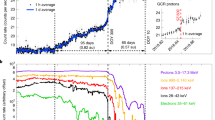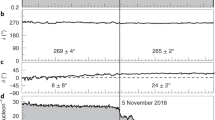Abstract
The interaction of the interstellar and solar winds is complex, as revealed by differences in intensities and anisotropies of low-energy ions (>0.5 MeV per nucleon) originating inside the heliosphere and those of higher-energy Galactic cosmic rays (>70 MeV per nucleon) originating outside, in the Milky Way. On 5 November 2018, Voyager 2 observed a sharp decrease in the intensity of low-energy ions and a simultaneous increase in the intensity of cosmic rays, indicating that Voyager 2 had crossed the heliopause at 119 au and entered interstellar space about six years after Voyager 1. Unlike Voyager 1, which found that two interstellar flux tubes had invaded the heliosheath and served as precursors to the heliopause, Voyager 2 found no similar precursors. However, just beyond the heliopause Voyager 2 discovered a boundary layer, in which low-energy particles streamed outward along the magnetic field and cosmic ray intensities were only 90% of those further out.
This is a preview of subscription content, access via your institution
Access options
Access Nature and 54 other Nature Portfolio journals
Get Nature+, our best-value online-access subscription
$29.99 / 30 days
cancel any time
Subscribe to this journal
Receive 12 digital issues and online access to articles
$119.00 per year
only $9.92 per issue
Buy this article
- Purchase on Springer Link
- Instant access to full article PDF
Prices may be subject to local taxes which are calculated during checkout







Similar content being viewed by others
Data availability
Most of the CRS data can be obtained by clicking on the DATA link at https://voyager.gsfc.nasa.gov/ and following other links to obtain rate and flux data. All data that were used in the figures can be provided by the corresponding author on request.
References
Burlaga, L. F. & Ness, N. F. Voyager 1 observations of the interstellar magnetic field and the transition from the heliosheath. Astrophys. J. 784, 146–159 (2014).
Burlaga, L. F., Ness, N. F. & Stone, E. C. Magnetic field observations as Voyager 1 entered the heliosheath depletion region. Science 341, 147–150 (2013).
Gurnett, D. A., Kurth, W. S., Burlaga, L. F. & Ness, N. F. In situ observations of interstellar plasma with Voyager 1. Science 341, 1489–1492 (2013).
Krimigis, S. M. et al. Search for the exit: Voyager 1 at heliosphere’s border with the galaxy. Science 341, 144–147 (2013).
Stone, E. C. et al. Voyager 1 observes low-energy galactic cosmic rays in a region depleted of heliospheric ions. Science 341, 150–153 (2013).
Florinski, V., Stone, E. C., Cummings, A. C. & le Roux, J. A. Energetic particle anisotropies at the heliospheric boundary. II. Transient features and rigidity dependence. Astrophys. J. 803, 47–54 (2015).
Strumik, M., Czechowski, A., Grzedzielski, S., Macek, W. M. & Ratkiewicz, R. Small-scale local phenomena related to the magnetic reconnection and turbulence in the proximity of the heliopause. Astrophys. J. Lett. 773, L23–L27 (2013).
Strumik, M., Grzedzielski, S., Czechowski, A., Macek, W. M. & Ratkiewicz, R. Advective transport of interstellar plasma into the heliosphere across the reconnecting heliopause. Astrophys. J. Lett. 782, L7–L11 (2014).
Strauss, R. D., Potgieter, M. S., Ferreira, S. E. S., Fichtner, H. & Scherer, K. Cosmic ray modulation beyond the heliopause: a hybrid modeling approach. Astrophys. J. Lett. 765, L18–L23 (2013).
Luo, X. et al. A numerical simulation of cosmic ray modulation near the heliopause. II. Some physical insights. Astrophys. J. 826, 182–191 (2016).
Cummings, A. C. et al. Galactic cosmic rays in the local interstellar medium: Voyager 1 observations and model results. Astrophys. J. 831, 18–38 (2016).
Washimi, H., Tanaka, T. & Zank, G. P. Time-varying heliospheric distance to the heliopause. Astrophys. J. 846, L9–L14 (2017).
Burlaga, L. F. et al. Magnetic field and particle measurements made by Voyager 2 at and near the heliopause. Nat. Astron. https://doi.org/10.1038/s41550-019-0920-y (2019).
Gurnett, D. A. & Kurth, W. S. Plasma densities near and beyond the heliopause from the Voyager 1 and 2 plasma wave instruments. Nat. Astron. https://doi.org/10.1038/s41550-019-0918-5 (2019).
Krimigis, S. M. et al. Energetic charged particle measurements from Voyager 2 at the heliopause and beyond. Nat. Astron. https://doi.org/10.1038/s41550-019-0927-4 (2019).
Richardson, J. D., Belcher, J. W., Garcia-Galindo, P. & Burlaga, L. F. Voyager 2 plasma observations of the heliopause and interstellar medium. Nat. Astron. https://doi.org/10.1038/s41550-019-0929-2 (2019).
Stone, E. C. et al. Cosmic ray investigation for the Voyager missions: energetic particle studies in the outer heliosphere—and beyond. Space Sci. Rev. 21, 355–376 (1977).
Fisk, L. A., Kozlovsky, B. & Ramaty, R. An interpretation of the observed oxygen and nitrogen enhancements in low-energy cosmic rays. Astrophys. J. Lett. 190, L35–L38 (1974).
Pesses, M. E., Jokipii, J. R. & Eichler, D. Cosmic ray drift, shock wave acceleration, and the anomalous component of cosmic rays. Astrophys. J. Lett. 246, L85–L89 (1981).
Strauss, R. D. & Fichtner, H. Cosmic ray anisotropies near the heliopause. Astron. Astrophys. 572, L3–L6 (2014).
Potgieter, M. S., Vos, E. E., Munini, R., Boezio, M. & Di Felice, V. Modulation of galactic electrons in the heliosphere during the unusual solar minimum of 2006-2009: a modeling approach. Astrophys. J. 810, 141–150 (2015).
Aguilar, M. et al. Precision measurement of the (e + + e −) flux in primary cosmic rays from 0.5 GeV to 1 TeV with the Alpha Magnetic Spectrometer on the International Space Station. Phys. Rev. Lett. 113, 221102 (2014).
Shikaze, Y. et al. Measurements of 0.2–20 GeV/n cosmic-ray proton and helium spectra from 1997 through 2002 with the BESS spectrometer. Astropart. Phys. 28, 154–167 (2007).
Acknowledgements
We thank L. Burlaga for providing magnetic field data before publication. A.C.C. acknowledges support from the International Space Sciences Institute in Bern, Switzerland, to participate in the international team The Physics of the Very Local Interstellar Medium in the autumn of 2018. This work was supported by NASA under grant NNN12AA01C.
Author information
Authors and Affiliations
Contributions
All authors contributed to the production of this manuscript. A.C.C. and E.C.S. wrote the text. A.C.C., B.C.H. and N.L. performed the data analysis and A.C.C. and B.C.H. prepared the figures. All authors participated in reviewing and commenting on the paper and on the editor’s and referees’ comments.
Corresponding author
Ethics declarations
Competing interests
The authors declare no competing interests.
Additional information
Peer review information Nature Astronomy thanks Horst Fichtner and the other, anonymous, reviewer(s) for their contribution to the peer review of this work.
Publisher’s note Springer Nature remains neutral with regard to jurisdictional claims in published maps and institutional affiliations.
Rights and permissions
About this article
Cite this article
Stone, E.C., Cummings, A.C., Heikkila, B.C. et al. Cosmic ray measurements from Voyager 2 as it crossed into interstellar space. Nat Astron 3, 1013–1018 (2019). https://doi.org/10.1038/s41550-019-0928-3
Received:
Accepted:
Published:
Issue Date:
DOI: https://doi.org/10.1038/s41550-019-0928-3
This article is cited by
-
Where solar wind meets interstellar medium
Nature Astronomy (2023)
-
Cosmic ray feedback in galaxies and galaxy clusters
The Astronomy and Astrophysics Review (2023)
-
Oblique and rippled heliosphere structures from the Interstellar Boundary Explorer
Nature Astronomy (2022)
-
Observations of the Outer Heliosphere, Heliosheath, and Interstellar Medium
Space Science Reviews (2022)
-
The Structure of the Large-Scale Heliosphere as Seen by Current Models
Space Science Reviews (2022)



